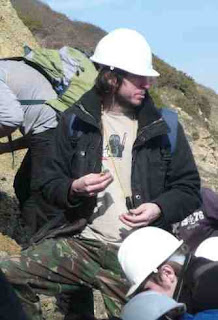This passage comes from Phil Manning's book Grave Secrets of Dinosaurs:
I saw a tall figure, with a rucksack and the signature paleontologist field hat, walking toward the Society buildings down Water Place. As the figure drew nearer, I knew he had to be Tyler. Dozens of people had passed in the last half hour, and none looked like they belonged in the field. As he entered the building, I instinctively walked over to greet him. As Tyler and I shook hands, he asked how I knew it was him, and I said it was obvious. "You look like a field paleontologist!"
Bob Bakker is a stereotypical palaeontologist in many ways, even wearing the sort of hat that would be expected, but the majority of palaeontology does not take place in areas like the Badlands of America. The most common head-wear for palaeontologists is probably the standard hard hat. Rock exposures are obviously where fossils are most likely to be found and this often involves going to cliff faces and quarries. A hard hat is essential, especially if trying to rescue a fossil in situ.
I like to think Bakker's beard is another part of the typical palaeontologist, but sadly that isn't true. I've recently grown a beard and like to claim that it is "the palaeontologist look" but really there is no palaeontologist look (and the majority on my course are actually girls ).
One thing that we are constantly told on my course is that palaeontologists will always have a hand lens close by. Over on the right is actually a picture of yours truly, sporting my hard hat. Round my neck I have the obligatory hand lens dangling. There are a few pieces of equipment we carry on field trips. The geological hammer is the most satisfying, though many will also carry chisels and even picks. Note pads and clipboards may not sound like the stuff of rugged outdoors-men, but they are essential. This also means carrying colouring pencils a lot, despite the fact that we like to claim that all geographers do is colouring in (we do extreme colouring in). Among other bits of useful equipment includes a compass clinometer, GPS devices, plastic bags for specimens, safety specs, tape measure, pen knife, camera and more.
Clothing is not always predictable except that it must suit the weather. I have actually noticed that palaeontologists do have a habit of wearing palaeontology themed t-shirts (even trainers if you are some kind of awesome). Jeans are not recommended in the field, but not everyone follows that. The only thing I can really state would be worn are proper boots with steel toe caps.
So apart from the rare stereotypical field palaeontologist with his hat and beard, it seems they are just like you and me (me especially). There may be behavioural clues though. If a person is carrying fossils around that might be a give away, or try talking loudly about dinosaurs and see if they offer their opinion; I'm shy and even I struggle to resist that. If outdoors you might see them staring intently at the rocks, though they may just be your average geologist (you know, the sort you see all the time...). If they look at the floor a lot then they may be after fossils, it is much easier to pick them up off the ground than to chisel them out of the rock face. I'll end with a picture of someone staring at the rocks, me again:
Well, this was quite a random post.



No comments:
Post a Comment